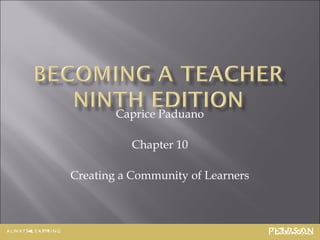
Introduction to Education, Chapter 10, Caprice Paduano
- 1. Caprice Paduano Chapter 10 Creating a Community of Learners 10-1
- 2. 1. What determines the culture of the classroom? 2. How can you create a positive learning environment? 3. What are the keys to successful classroom management? 4. What teaching methods do effective teachers use? 5. What is taught in schools? 6. How is the school curriculum developed? 10-2
- 3. Classroom Culture determined by the manner in which teachers and students participate in common activities Classroom Climate atmosphere or quality of life in the classroom • Determined by •How teachers interact with students •Exercise of authority •Warmth and encouragement shown •Amount of competition or cooperation encourages 10-3
- 4. Caring Classroom • Help students learn to fullest potential Attention to Physical Environment • Place furniture and seat students to enhance learning and movement in room Classroom Organization • Structure tasks, group students and use resources to optimize learning for all 10-4
- 5. Grouping Between- Class Ability Grouping assigned by ability or achievement or goals (tracking) • Does not contribute to greater achievement Within-Class Ability Grouping assigned to small homogenous groups • Can cause some students to be under taught and regrouping does not occur 10-5
- 6. Cooperative Learning Small groups 4-6 students Assignment required students to help each other on group project Groups may be set up to compete against one another Students may contribute based on talent, interests, and abilities 10-6
- 7. Delivering Instruction •Authentic Pedagogy Helps Students • Construct knowledge • Acquire deep knowledge • Engage in substantiative conversations • Make connections between knowledge and real world 10-7
- 8. Time Allocated Time Academic Learning Time Opportunity to Learn (OTL) Block Scheduling 10-8
- 9. Classroom Management Techniques Creating a Caring Classroom Classroom Organization Student Grouping Authentic Learning Structuring Time 10-9
- 10. Discipline Methods teachers use after misbehavior Management Prevention oriented Goal of Management – Maximize student attention and minimize disruption 10-10
- 11. Democratic Classroom Allowing students more power and responsibility over classroom activities Choice Theory Human beings make choices that enable them to meet the need for belonging, power, freedom, and fun Preventive Planning Teacher Behaviors Eyes-in-the-back-of-the-head (with-it-ness) Ripple effect – using models to communicate expectations 10-11
- 12. Establishing Rules & Procedures •Should be: • Carefully planned with clear explanations, examples and practice • Enforced consistently and fairly • Procedures (routines) and consequences (failure to follow rules) taught to students 10-12
- 13. Organization and Planning for Instruction •Authentic Learning Tasks • Tasks that enable student to see connection between learning and real world 10-13
- 14. Effective Responses to Student Behavior •Severity of Misbehavior •Zero Tolerance •Constructive Assertiveness •Assertive Discipline Steps •Teacher Problem Solving •Developing Your Own Classroom Management Approach 10-14
- 15. Stepsto help misbehaving students make proper choices •Misbehaving student evaluates and takes responsibility for behavior •Student plans agreed upon future behavior •Required student commitment to plan •Excuses no accepted •Consequence pointed out not punishments •Commitment by teacher to student 10-15
- 16. 3 philosophies of teacher response to student misbehavior Relationship-listening Confronting-Contracting Rules and Consequences 10-16
- 17. Models of Teaching Methods Based on Learning New Behaviors Direct instruction – systematic instructional method that focuses on knowledge from teacher to student Direct Instruction Steps Orient students Review Present Assess Practice or apply Feedback Homework Review periodically 10-17
- 18. Mastery Learning •All students can learn given time •Student learn best in structured program •Mastery Learning Cycle • Set objectives • Teach • Feedback • Correct • Teaching, Testing, Reteaching, Retesting 10-18
- 19. Methods Based on Child Development •Modeling – thinking out loud • Demonstrate thinking • Making students aware of thinking • Focus students on applying thinking 10-19
- 20. Constructivist teaching •Teacher elicits prior knowledge •Teacher presents material •Students absorb and use information to construct meaning •Students reflect and talk with others to construct meaning and solve problems Scaffolding teacher provides clues, encouragement and suggestions to guide learning Zone of Proximal Development point at which students need help to continue learning 10-20
- 21. Methods Based on the Thinking Process Information Processing – cognitive branch of science concerned with how people use their long and short term memory to solve problems Sensory Memory Working Memory Long-Term Memory 10-21
- 22. Inquiry or Discovery Learning •Students given opportunities to discover knowledge for themselves Peer Mediated Instruction •Motivation by students to excel and learn Group Investigation •Teacher create environment that allows students to determine what and how they will learn Peer Tutoring •Students are tutored by others in same class or grade Cross Age Tutoring •Older students tutoring younger 10-22
- 23. Curriculum •Course of study •Knowledge students are to learn •Planned learning experiences •Intended learning outcomes •All experiences at school 10-23
- 24. Kinds of Curricula •Explicit Overt goals the school intended to be taught •Hidden Implicit attitudes unintentionally taught •Null Knowledge not taught •Extracurricular / Co curricular School sponsored activities 10-24
- 25. Tyler Rational Questions to be answered when planning a curriculum • What purposes should be attained? • What experiences can attain purposes? • How can experiences be organized? • How to determine if purposes are attained? 10-25
- 26. Focus of Curriculum Planning •Macro – Curriculum content decisions apply to large group of students •Micro – Curriculum content decisions apply to school or class 10-26
- 27. Student Centered Curriculum Growth and development of students emphasized with content, more typical in elementary schools Subject Centered Curriculum Logical order of curriculum emphasized, more typical of high school Integrated curriculum Curriculum drawn from different subject areas focused around theme 10-27
- 28. Federal Government State Government Curriculum Planning Team Teacher 10-28
- 29. SocialIssues and Changing Values Textbook Publishing 10-29